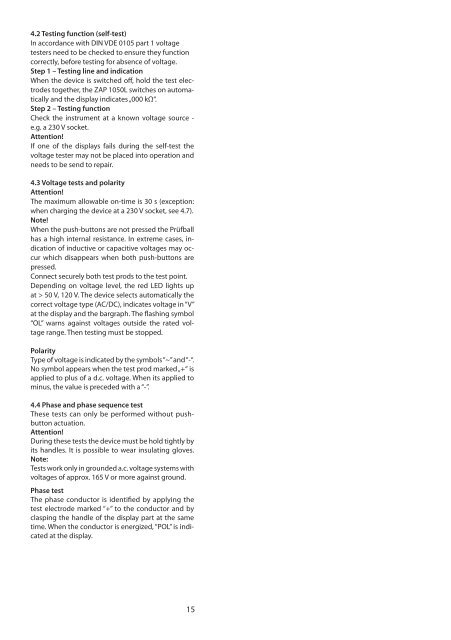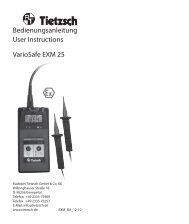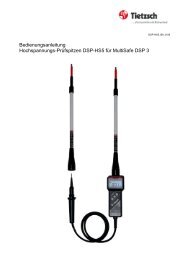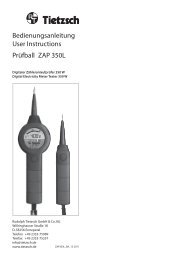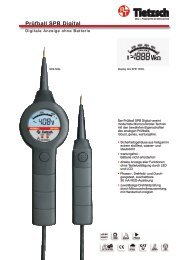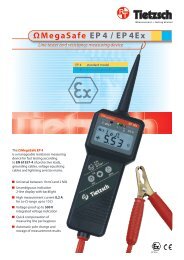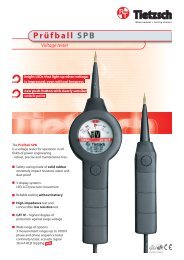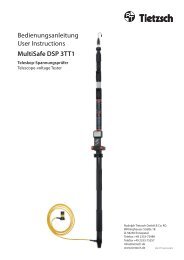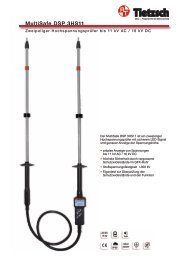Bedienungsanleitung ZAP 1050L - bei Tietzsch
Bedienungsanleitung ZAP 1050L - bei Tietzsch
Bedienungsanleitung ZAP 1050L - bei Tietzsch
Sie wollen auch ein ePaper? Erhöhen Sie die Reichweite Ihrer Titel.
YUMPU macht aus Druck-PDFs automatisch weboptimierte ePaper, die Google liebt.
4.2 Testing function (self-test)<br />
In accordance with DIN VDE 0105 part 1 voltage<br />
testers need to be checked to ensure they function<br />
correctly, before testing for absence of voltage.<br />
Step 1 – Testing line and indication<br />
When the device is switched off, hold the test electrodes<br />
together, the <strong>ZAP</strong> <strong>1050L</strong> switches on automatically<br />
and the display indicates „000 kΩ“.<br />
Step 2 – Testing function<br />
Check the instrument at a known voltage source -<br />
e.g. a 230 V socket.<br />
Attention!<br />
If one of the displays fails during the self-test the<br />
voltage tester may not be placed into operation and<br />
needs to be send to repair.<br />
4.3 Voltage tests and polarity<br />
Attention!<br />
The maximum allowable on-time is 30 s (exception:<br />
when charging the device at a 230 V socket, see 4.7).<br />
Note!<br />
When the push-buttons are not pressed the Prüfball<br />
has a high internal resistance. In extreme cases, indication<br />
of inductive or capacitive voltages may occur<br />
which disappears when both push-buttons are<br />
pressed.<br />
Connect securely both test prods to the test point.<br />
Depending on voltage level, the red LED lights up<br />
at > 50 V, 120 V. The device selects automatically the<br />
correct voltage type (AC/DC), indicates voltage in “V”<br />
at the display and the bargraph. The flashing symbol<br />
“OL” warns against voltages outside the rated voltage<br />
range. Then testing must be stopped.<br />
Polarity<br />
Type of voltage is indicated by the symbols “~” and “-“.<br />
No symbol appears when the test prod marked „+“ is<br />
applied to plus of a d.c. voltage. When its applied to<br />
minus, the value is preceded with a “-”.<br />
4.4 Phase and phase sequence test<br />
These tests can only be performed without pushbutton<br />
actuation.<br />
Attention!<br />
During these tests the device must be hold tightly by<br />
its handles. It is possible to wear insulating gloves.<br />
Note:<br />
Tests work only in grounded a.c. voltage systems with<br />
voltages of approx. 165 V or more against ground.<br />
Phase test<br />
The phase conductor is identified by applying the<br />
test electrode marked “+” to the conductor and by<br />
clasping the handle of the display part at the same<br />
time. When the conductor is energized, “POL” is indicated<br />
at the display.<br />
15


